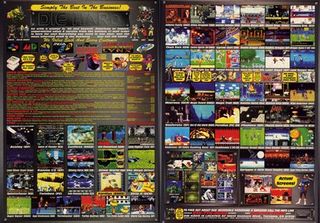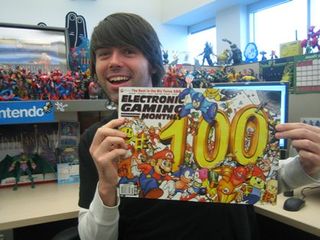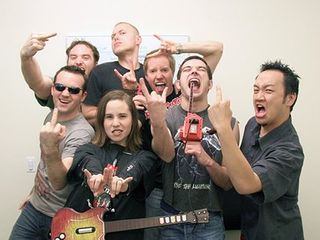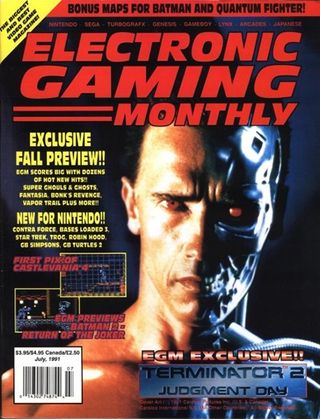EGM: Gone but not forgotten
We pour out a 40 for the magazine that shaped our childhoods – and our careers
If you're reading this site, then you're probably already aware that this week saw the loss of a major institution in gaming journalism. On Tuesday, Jan. 6, Electronic Gaming Monthly - a magazine that's been synonymous with US hardcore gaming since 1989 - was shut down just shy of publishing its 20th-anniversary issue. Brought about as part of a corporate buyout, the closure of EGM and the mass layoffs at the 1UP Network have put many of our most talented colleagues out of work, and represent nothing less than the end of an era for our industry.

Cover scans taken fromMagweaseland1UP
Although GamesRadar and its companion magazines have long been in direct competition with EGM, the immediate reaction throughout the office here at Future US was one of horror. EGM was, for many of us, our introduction to gaming journalism and our favorite magazine growing up. It was a font of information on everything that was cool about videogames, and it's fair to say that most of us wouldn t be writing about gamesnow if EGM hadn't been there to show us how it was done.
To pay our respects and acknowledge our debt to the magazine that defined gaming culture for 20 years, we the editors of GamesRadar - along with editors from other sites and magazines - would like to say a few words.

Chris Slate
Editor in Chief, Nintendo Power
I'll always remember EGM as being the first magazine that really "got" core gamers. Back when there were very few game magazines - and way before the internet -EGM broke all the news, showed all the games and systems first, and was clearly written by people that were just as passionate about gaming as I was. Even when I landed a job at the old Game Player's magazine, getting a new issue of EGM made me feel like a kid at Christmas. Over the many years since those early days, EGM always stayed true to core gamers, never talked down to them, and continued to offer some of the best exclusives and articles around. Great products made by talented teams don't deserve to end this way. I've been on a magazine that folded, and to be honest, it deserved to. EGM didn't. My best to its staff, and my sincere thanks to everyone that made the magazine such a great read over its long and storied run.

Above: Nostalgia!

Eric Bratcher
Executive Editor, GamesRadar US
My favorite EGM story is the role the magazine played in creating the Mortal Kombat character ERMAC. When an arcade machine first powers up, it often displays a bunch of mostly intelligible programmer text - it's the machine checking to make sure all its parts are connected and so on. But in the case of the original Mortal Kombat machine, this power-up text also listed the name of a super-secret hidden character - a green-clad lizard ninja named Reptile who only appeared if the player won two rounds in a row in a particular arena, never blocking or taking damage but ending the match with a fatality. Being so well hidden, Reptile instantly became the character every hardcore player had to find and fight. And right below Reptile's listing in the power-up text was the word ERMACS.
Sign up to the 12DOVE Newsletter
Weekly digests, tales from the communities you love, and more

Above: The true origin of Ermac
Now, ERMACS was actually short for "Error Macros" - it's a programming term. But the gamers of the world didn't know that, and they concluded it must be the name of another hidden character. Rumors swirled, but the game's manufacturer, Midway, insisted there was no character named ERMAC.
That's where EGM magazine comes in. They gota letterfrom a guy named Tony Casey, who claimed he'd played against Ermac and even sent in a Polaroid picture of the screen. And they ran it. From that moment, it was on.

The pic eventually turned out to be a hoax, but it didn't matter. The biggest, most respected, important gaming mag in the country (maybe the world) had just run a picture of Ermac, and nobody reads corrections. Ermac's myth grew to the point that the Midway itself relented. Ermac, a red-suited ninja, debuted as a playable character in Ultimate Mortal Kombat 3. That, dear friends, is the power of the people and the ultimate testament, at least in an old arcade gamer's mind, to EGM's clout.

Dan Amrich
Senior Editor, Official Xbox Magazine
In college, as I was trying to pick a career, I read EGM whenever I could. Then when I got my first job, writing about music, I'd pick up issues at Penn Station in New York City and read them on my train commute. The first gaming job I applied for was to be an EGM editor -I was ready to move to Illinois and work with Ed Semrad and Steve Harris. In fact, since his love of Mountain Dew was a running joke in the mag in the late '80s, I sent my resume to Steve Harris directly in an empty two-liter Mountain Dew bottle. Never heard back...

Above: Multi-voice reviews -the early years
Even when I was working at EGM's traditional arch-rival GamePro, I would open their issues and go "damn, I wish I d thought of that first," or "shit, they just beat me to the punch on that story we were working on." It was the very definition of healthy competition -I really was driven to come up with better ideas and stories than they were doing, and they were doing a great job. And Dan Hsu was always a complete gentleman - he left the competition at the newsstand and was always friendly and genuine in person. Same with James Mielke. Class acts.

Mikel Reparaz
Senior Editor, GamesRadar US
I'm proud to say that I've been an EGM reader ever since I saw the first Buyer's Guide issue at a toy store in 1989. Before that, "games journalism" (at least as far as I knew about it) was something relegated to review columns in the back of tech magazines. There was Nintendo Power, and there were those How to Win at Nintendo Games books by Jeff Rovin, but actual reporting and critical reviews were too niche-y to really be considered an industry. When EGM arrived, it made that shit mainstream.

Above: The only time Predator for the NES got on the cover of anything
Not that I really thought aboutthat at the time; being 10, my interest in EGM's beefy volumes of console-agnostic game-porn was more about drooling over the latest consoles and games from Japan, and reading about stuff I wasn t allowed to own. I used its secret knowledge to sagely advise all my friends to not buy an NES, because the Super Famicom was right around the corner (in reality, the SNES was a good two-and-a-half years away). I never bought a game unless EGM liked it. Every issue was like an in-depth Christmas catalog, and even the ads were awesome.

Above: An ad thatwas awesome
Over the years, I did my best to get EGM's attention, with no success. Probably my most pathetic attempt was when, at 15,I tried to get a piece of envelope art I'd drawn published; it was a picture of a cute-ified, anime-style Sub-Zero hosting a cooking show in which the main ingredient was then-EGM mascot Sushi-X's severed head and spine. (In retrospect, that probably wasn't the best way to ingratiate myself to the editors). As an excuse for sending the thing, I d printed out a bunch of (fake, I later learned) Mortal Kombat II arcade cheats off of AOL, which I tried to pass off as my own. Crass and shameful, I know, but at least nobody fell for it.

Above: Every Nintendo fan's wet dream, circa 1989
Even after I started working full-time in the games industry, I never saw the magazine as anything other than the gold standard of print games journalism. After a lifetime of quietly envying the men and women lucky enough to work there, I can only offer them my saddest condolences and best wishes for the future.

Brett Elston
Senior Nintendo Editor, GamesRadar US
Other than the first 30 issues of Nintendo Power, no printed object in history had more of an effect on me than EGM. I picked it up for the first time in 1992, when Street Fighter II mania was spreading across the entire globe,issue 31to be precise. From that point on, EGM was the magazine to read in my school. Everyone subscribed and we'd all sit around chatting about the cover, which games we were going to ask for, all that goofy childish shit I'd love to revisit.

Above: Inspiration bound and stapled in magazine form
Cutting to the late '90s, I realized that games journalism was my passion, that I simply had to work in this industry andEGM was the Holy Grail. That was my future, no doubts at all. I would graduate college and be working at EGM by 26, no matter the personal sacrifice. Imagine my squealing delight when I found out the mag was located in Illinois, the very state I was in. The dream took a crushing blow, though, when they announced -mere months before I finished school -a move to San Francisco. Was I prepared to hop 2,000 miles away for this dream? Hell yes.
Finished college, sent emails around, did a lot of legwork to find some kind of in. I eventually landed some freelance gigs at PSM and ultimately helped launch GamesRadar in the ancient months of 2006, but the inspiration behind it all was EGM through and through. From the review crew to the editor banter to the back-breaking, 400-page issues from 1994, it was a cherished magazine I'll never forget. Guess what I made sure to bring when I finally made that move from Illinois to San Francisco?

Above: EGM 100, the only Top 100 games list that will ever include Space Megaforce
I came out here with nothing more than a suitcase, but made damn sure my EGM 100 was in my carry-on. It s still here right next to my desk as I type this. Seeing it close is truthfully heartbreaking, not unlike watching Nintendo today slowly distance itself from everything I associated it with. With EGM gone and Nintendo drifting into irrelevance, all that's left of my beloved memories are Ernest P. Worrell quotes... and Jim Varney died in 1999.

Christian Nutt
Features Director, Gamasutra
EGM has been such a part of my life for such a long time it's difficult for me to actually talk about it yet -- I'm still processing what it being gone really means. The magazine changed so much from year to year, from editor to editor, and my relationship with it changed every time... it's a long journey.
The most exciting moment for me -- just a bit more exciting than those days in the early '90s when my latest issue would come in the mail and I would shut down everything and just read -- was when I first saw my work in the magazine in 2001. I'd been laid off from my first industry job, but seeing my name and my words inside that magazine made me forget it. That joy is the kind of thing you'd think you'd never forget, but I hadn't thought about in ages it till this happened...
Really, while EGM made me a fan in its early years, the friendships I made with the editors, the atmosphere of that office, the ideals the magazine represented -- those meant a lot to me during my career, and personally.

Covers? In a weird way, the September 1991 cover might be my favorite -- it has the Japanese Mega CD on it, the weird screenshots-in-the-CDs, really bringing me the excitement of import gaming (as it was, and I was mad for it) and the exciting new world of RPGs. That hit right around when Super NES came out, and before the Sega CD came to the U.S., and the whole feel of that era just comes rushing back when I look at that cover.

Ryan McCaffrey
Senior Editor, Official Xbox Magazine
EGM was the gaming magazine - and in fact the magazine, period - that I grew up on, and I have nothing but fond memories of it. From the coin-op section to the Japan section to the reviews of the biggest games (Street Fighter II for the SNES!), I always looked forward to it landing in my mailbox each month. It will be dearly missed.

Above: Street Fighter II coming to SNES was the biggest of big deals

Chris Hoffman
Senior Editor, Nintendo Power
EGM wasn't the first video game magazine I read (that distinction goes to Nintendo Power or maybe Game Players), but it was the first one that I was really enthused about, and the first one I spent my own money to subscribe to. The first issue was fairly forgettable, but I distinctly remember buying the second issue at Crown Books. The cover featured the Genesis, TurboGrafx, and Super Famicom, as well as the Game Boy, apparently flying through the air, heralding the coming of the 16-bit era. It was actually some Metroid codes that convinced me that I had to buy the magazine, but after I took it home and read it cover-to-cover, it taught me that there was so much more to this hobby than I had ever realized! During its early years, it was essentially the Time Magazine of gaming. It also influenced me as a writer; when I look back at the gaming articles I wrote (for a fanzine circulated among my friends!) from that time, it s obvious that I was taking cues from EGM.

Above: Are you ready for... THE FUTURE!?
As I got older and became serious about being a games writer, EGM looked like the kind of publication that would be my dream job, but due to its geographic location (Chicago at the time), it wasn't something I actively pursued. Over the years I did, however, make several cameo appearances in its pages -including in the high-score charts, letters column, and a random E3 photo -further cementing its place as one of my favorite magazines. I didn't agree with or enjoy everything the magazine did, of course, but I did read every single issue thoroughly and still have the entire collection threatening to crush my closet shelves. If that's not a magazine that inspires dedication, I don't know what is.

Chris Antista
Associate Editor, GamesRadar US
As much as folks complain about console forum fanboys, we must remember that schoolyard discourse was just as vicious pre-interwebz. In the early '90s, debating Genesis and Super NES could turn brother against brother faster than you could pop an ill-timed erection while dressing out for PE. And since Nintendo wasn't yet the legacy it is today, I was constantly taking heat for standing by Mario while the Genesis was hosing my friends down with fleeting Baditude.

Above: That picture was taken yesterday
So by 1993, Sonic the Hedgehog was upon us, every bit as awesome as it was exclusive, a fact my dipshit friends couldn't stop reminding me of. Their console had Blast Processing, mine didn't, and there was no denying it. That is, until the February '93 issue ofElectronic Gaming Monthly offered me a divine refutation: Bubsy: Claws Encounters of the Furred Kind!

Above: In hindsight... Bubsy was kind of an asshole
I memorized every word of that two-page preview and frequently recited the Clinton-era hyperbole, like "16 MEG of topnotch sights and sounds!" and "a strong contender for the game of the year for Super NES in 1993!" (The game was clearlyinspirational, judging by the author's frequent use of the punctuation markon Bubsy's T-Shirt.) So what if it was coming out on the Genesis too!? My SNES' superior hardware would ensure that I played the definitive version. Bubsy's visual might was evident right there on the page - so as long as the Bubster could move as fast as Sonic, in the words of the immortal bobcat, "What could possibly go wrong?"

Above: No one spoiled death animations like the folks at EGM
Every day I brought that issue to school, using the abundant character art found across EGM's two-page spread as a reference for drawing Bubsy kicking the shit out of Sonic on all my notebooks, thus tormenting the Sega sect even when we weren't permitted to speak. And it worked! Of course, time has shown that EGM and I were fighting a losing battle in a greater console war far beyond our understanding. But that was all part of the fun of living in that moment intime -truly one of the most exciting and passionate eras gaming has ever seen -and EGM was with me every step of the way. They will be missed.

Charlie Barratt
Senior Editor, GamesRadar US
EGM was a beloved and iconic magazine, but in the end, it was still just a magazine. The real loss this week is the people behind the publication -without a doubt, some of the most enthusiastic, authoritative and entertaining voices to ever talk about videogames. And you know what? They're super nice, too. I'll always remember meeting and hanging out with Shane Bettenhausen in Las Vegas for a Midway convention. Although I had been writing about games for less than six months at that time, and he was the Shane from the EGM, he treated me as an equal. Forget experience or celebrity... we were both gamers, and that was all that mattered.

Above: Some of the people (formerly) behind the publication
Image ganked fromhere.
Everyone I know from EGM or 1UP is like that. Technically they were the competition, but in reality, they were kindred souls. And I have no idea why I'm writing this in the style of a eulogy; these guys' (and gals') voices are too talented and too unique to stay silent for very long. Like the rest of you, I can't wait to see how they unleash their considerable creative forces next. Wherever and whatever that is, I'm already a fan.

Tyler Nagata
Senior PC Editor, GamesRadar US
At the tender age of 12, I had no idea that I d eventually get to work in the games industry. All I knew back then was that videogames were pretty much the best thing ever, and that the best place to get previews and reviews was the latest issue of EGM.

My fondest EGM memory was when I opened the May, 1992 issue. Super Double Dragon for the SNES was on the cover, along with promises about details on the 16-bit Fighting Action that the game would surely deliver. Inside, I found that the magazine had decided to print and respond to a letter I had sent them.

If I had known then that I would eventually get to meet the staff and future Editor-in-Chief of EGM at press events to report on the latest games (which wouldput Super Double Dragon's "16-bit Fighting Action" to shame), I probably would've peed my pants.

Shane Patterson
Associate Features Editor, GamesRadar US
EGM is the reason why I'm here. My first issue -way back in the Gulf War year of '91 -broke news of the first Ren & Stimpy game ever made (for the Game Boy, no less). Withits wealth of information, low-res screens and trial-by-fire magazine design, I was hooked instantly. Each month, I begged my parents for a new issue, usually succeeding until I was able to pay for a subscription myself in 1996. Ah, seventh grade. Without the internet, these quirky editors were all I had when it came to videogame info. The pleasant mixture of hilarious April Fool's pranks and in-office jokes that you had to scour the pages to understand immediately endearedthe writers to me. Hell, I was even caught up in their personal lives when they moved their offices from Chicago to San Francisco.

Above: Yes, 1991 was a damn good year
It's weird that, upon graduating from college, I began work as an immediate competitor to the only magazine I consistently read since I was in first grade. But I harbor no hard feelings, and I respect everyone who has ever worked for EGM/1UP. Like many of you, I stayed a subscriber until the bitter end and only wish that everyone involved can land on their feet quickly.
Want to pay your respects to EGM? Sound off in the comments below.
Jan 9, 2008
Most Popular








